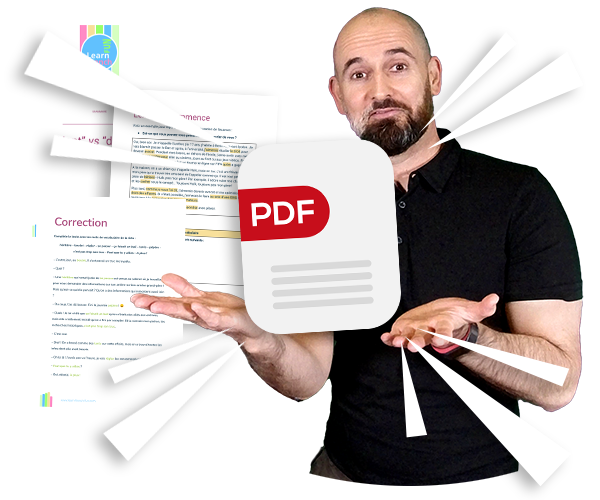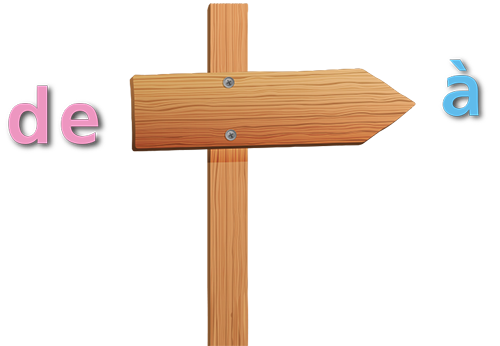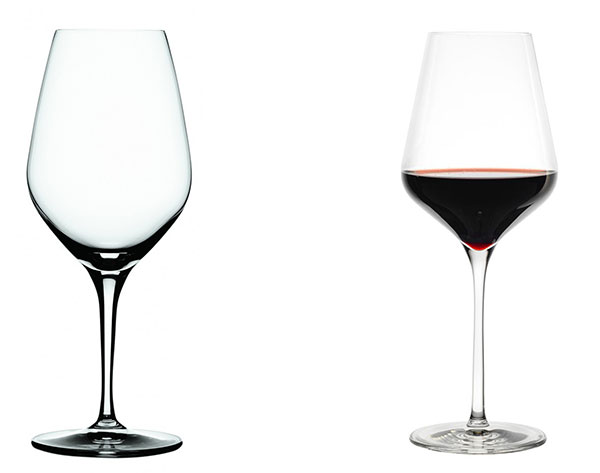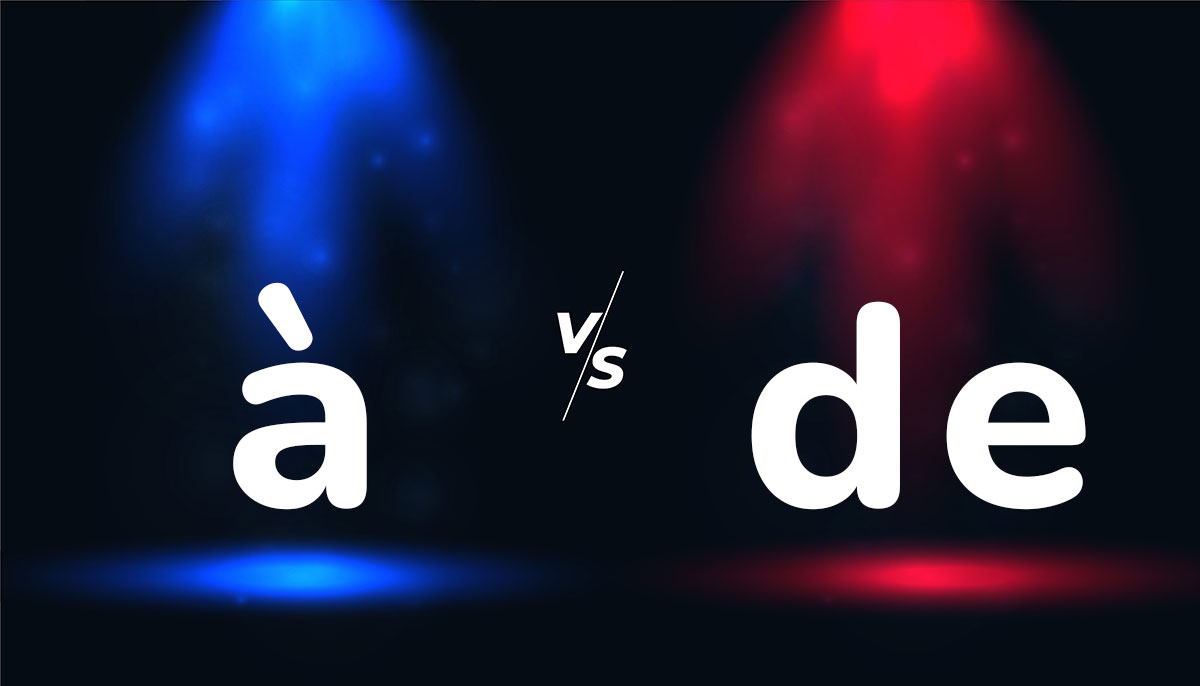In France, we use two different words for to: à and de. It can be confusing for beginners, so today we’re going to clear things up!
We’ll start by learning the basics:
- à is always used with a specific destination,
- while de can mean either of or from.
Then we’ll look at some examples to see how it works in practice. By the end of this post, you’ll be able to choose the right preposition every time!

PDF Bonus
We have prepared a free PDF to help you understand and master the French prepositions: “à” VS “de”.
👉 Download it for free
At the end, you will have exercises to practice with the correction. 👍
First: the general rules with French prepositions
1) After a French preposition, the verb is in the infinitive. This rule is valid for all prepositions, not only à or de.
2) With the prepositions à and de that we’re interested in today, there’s a certain logic, an idea that can help you remember the rule:
à →
de ←

But, in many expressions or with some verbs, the choice of à or de is arbitrary. That means it’s just the way it is! The choice of preposition is self-evident.
3) de is common in constructions with an adjective or noun that express a feeling.
Examples:
- Je suis content/heureux/triste de partir. (I am happy/sad to leave)
- J’ai envie/peur de partir. (I want to leave/I’m fear to leave)
4) But, with a verb that expresses a desire or a project, no preposition is used.
Examples:
- J’adore lire dans la voiture. (I love to read in the car🤢)
- Je déteste voyager en bateau. (I hate traveling by boat)
- Nous espérons partir en vacances bientôt. (We hope to go on vacation soon)
You see that between the verb that expresses the desire or plan and the verb in the infinitive, no preposition is used.
Do you like learning French with videos?
Receive our free video newsletter every Friday in your e-mail box. You will get 3 “Tips & Tricks” on grammar, vocabulary, phonetics or French culture.
👉👉 Sign up now!
Second: Let’s take a closer look at “à” and “de”
Let’s look at the 7 main points that will make it easy for you to know if you should use the French preposition à or the French preposition de:
1. When you express a “place”
We find the logic of à and de

- à: the arrival
- de : the departure, the starting point
Examples:
- Je vais à Nice pour les vacances (I’m going to Nice for the vacations)
- Je viens de Nice, et toi, tu viens d’où ? (I come from Nice, and you, where do you come from?)
💡 Note : Beware of contractions! Remember that :
- à + le = au
- à + les = aux
Example: Je vais au cinéma (I am going to the cinema)
- de + le = du
- de + les = des
Example: Toi, tu viens du Sud. (You come from the South)
2. With a French tonic pronoun (moi, toi…)
- à → possession
- de → to express that we did it.
Examples:
- C’est à moi ! = It’s mine. I own this object.
- C’est de moi ! = I made it. I made this object.
3. Between 2 nouns
⚠️ We use: de.
Examples:
- Mon téléphone de travail est un Nokia 5110. (My work phone is a Nokia 5110)
- Le yaourt de Siggis est à la vanille. (Siggis’ yogurt is vanilla)
4. With a French demonstrative pronoun (celui, celle…)
⚠️ With a demonstrative pronoun, we use: de.
Examples:
- C’est celui de mon beau-frère ! (It’s my brother-in-law’s!)
- Ma voiture est rouge, celle de ma mère est blanche. (My car is red, my mother’s is white)
Please try not to make a mistake between two nouns or with the demonstrative pronoun 🙏🙏🙏
Points 3 and 4 above are really important, because using “à” instead of “de” is really:
5. “à” or “de” to express the time
5.1. To express a time (moment) we use: à.
Examples:
- Je viens à 20h. (I come at 8pm)
- Elle prend son petit-déjeuner à 7h. (She has breakfast at 7am)
⚠️ Attention: if the moment is “more important” → a day, a month, a year, it is different!
For a day: NO preposition.
Examples:
- Je viens lundi. (I’m coming on Monday)
- Samedi, j’achèterai son livre. (On Saturday, I’ll buy his book)
- Ils sont rentrés dimanche. (They came home on Sunday)
For a month or a year: we use the preposition: en.
Examples:
- Je viendrai en 2029. (I will come in 2029)
- La France est redevenue championne du monde de foot en 2018. (France became the world soccer champions again in 2018)
5.2. To express the time, we find the logic of the arrows
- à : point of arrival,
- de : point of departure.
Example:
- Administration ouverte de 9h45 à 10h30 (Administration open from 9:45 to 10:30)
Well, what? 45 minutes a day is good enough, no? ! 😆
6. The food, the gastronomy
Be careful, here, the preposition is really important because it changes the meaning of what you say.
Until now, if you made a mistake, it was… a mistake, but normally, with the context of your sentence, we could understand what you really meant.
Even for points 3 and 4 (between two nouns, or after a demonstrative pronoun), we can understand your sentence. The error is difficult to hear for a French speaker, but we understand.
But here, with the example we’ll see, if you make a mistake, you change the meaning of the sentence!
Examples:
- Excusez-moi, auriez-vous un verre à vin ? (Excuse me, would you have a wine glass?)
- Excusez-moi, auriez-vous un verre de vin ? (Excuse me, would you have a glass of wine?)
What is the difference between the two sentences?
- With “à“: you express the purpose of the glass → It’s a glass to put wine in.
- With “de“: you express the content of the glass → I want a glass with wine in it!

7. French verbs with “à” and French verbs with “de”
The list is long, but here is a selection of the ones we use very often.
It’s really important to know if they are used with à or de because it will be very useful when you need to use a complement pronoun or a relative pronoun: y, en, dont, etc.
Try to memorize this list, which you’ll find in the Little Bonus PDF with everything we’ve seen today. In addition, in the Little Bonus PDF, you will find exercises with the correction to practice.
| Verbes avec “à” | Verbes avec “de” |
|---|---|
| aller à + nom de l’endroit arriver à + mon point d’arrivée téléphoner à qqn écrire à qqn penser à qqn/qqch participer à un évènement assister à un événement parler à qqn (interlocuteur) continuer à (action continue, se poursuit) | venir de + nom de l’endroit arriver de ← (mon point de départ) téléphoner de + lieu écrire de + lieu s’inquiéter de qqch s’occuper de qqn/qqch faire partie de qqch parler de qqn/qqch (sujet de conversation) continuer de (habitude) |
One last point before we conclude. An 8th point, you could say. It’s the use of à or de depending on whether your sentence is in the personal or impersonal form.
French Personal form VS impersonal form
As you already know, in French, you can express the same idea by constructing your sentence with a personal form (with an active, determined subject) or, with an impersonal form.
In this case, the subject is: “il” or “ce“, and it is only a grammatical subject, which does not designate anything or anyone.
Now let’s look at the relationship with the prepositions à and de.
French personal form: you use “à”
- Le français est difficile à apprendre. (French is difficult to learn)
The same sentence, but with an impersonal form construction:
- C’est difficile d’apprendre le français. (It’s hard to learn French)
You can see that here, the preposition de is used.
Both sentences have the same meaning, but depending on which way you choose to use it, you must use à or de.
In summary
1) à: the arrival
de: the departure, the starting point
This can help you very often when you hesitate, whatever the construction you want to use. Keep in mind these images of the arrows 👍
2) Be careful with contractions!
- à + le = au / à + les = aux
- de + le = du / de + les = des
3) Between 2 nouns or after a demonstrative pronoun → we use: de.
Le téléphone de ma sœur et celui de mon frère… (My sister’s phone and my brother’s phone…)
4) In the field of food, gastronomy, if you don’t use the right preposition, you risk changing the meaning of the sentence.
5) The personal form is built with à and the impersonal form with de.
6) And finally, depending on the meaning of your sentence, some verbs are used with the preposition à or de.
That’s all for today! I hope you enjoyed this lesson on French prepositions “à” and “de”. Don’t forget to practice using them in your own sentences. À la prochaine !
In the meantime, why not check out our other blog posts about learning French? We’ve got everything from grammar lessons to tips for improving your pronunciation.
And if you still have questions, don’t hesitate to leave a comment or contact us directly. We’re here to help you learn French and have fun while doing it!
Have fun using the gerund in all sorts of creative ways – just make sure you know what you’re doing before you try using it in a conversation with a native speaker!
Articles that might interest you:
- The Imperative in French: How to Conjugate Verbs in Imperative? When do You Have to Use the Imperative?
- The 10 Irregular Verbs in the French Subjunctive Mood
- Depuis, pendant, en, il y a, dans
- All the secrets of the French gerund!
- French verb moods
- How to use the tonic pronouns in French?
- How to use “en” and “y” pronoun in French?
- Difference between DONT and DUQUEL in French
- 10 common French verbs conjugated in the present tense. Beware of traps!
- The Direct Object Complement in French (C.O.D.) and direct complement pronouns (le, la, les…)




1 thought on “French prepositions: à VS de”
Comments are closed.